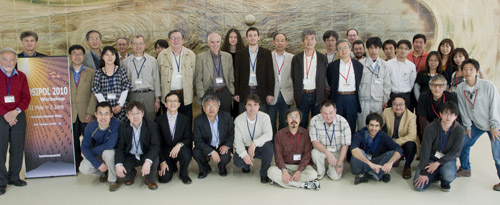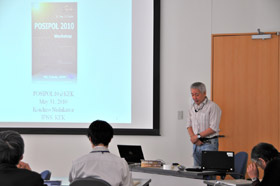| |
 |
Topics |
|
 |
The fifth POSIPOL workshop held at KEK
|
The POSIPOL 2010 workshop was held from 31 May to 2 June at KEK. It was the fifth in the POSIPOL series of workshops dealing with the physics aspects, the design issues, and the open questions concerning a polarized positron source in the framework of the next-generation electron-positron colliders such as the ILC or the Compact Linear Collider Study CLIC.
 |
| Participants of the 5th POSIPOL Workshop. |
| |
 |
| Koichiro Nishikawa, Director of Institute of Particle and Nuclear Studies of KEK, giving an opening address for the workshop. |
A total of 44 scientists from Europe, Asia and the US attended the workshop, including some via videoconference. The main topic of the POSIPOL 2010 was design of the polarized positron sources for the ILC and for CLIC. The only linear accelerator which used a positron beam was the SLAC Linear Collider (SLC) at SLAC National Accelerator Laboratory in the US "For CLIC, we will need to produce 18 times more positrons than SLC, and 65 times more for the ILC", said Dr. Louis Rinolfi (CERN), who is convener of the ILC/CLIC joint working group for positron studies, "these numbers show how far we are from what where want to be," Rinolfi said.
There are several approaches to provide the large numbers of positrons required for the next-generation linear colliders. One idea is "the undulator radiation scheme", which is included in the current ILC baseline design. It implies using the main linac electron beam passing through a helical undulator to generate high-energy photons which will be used to produce positrons from a target. Another scheme called the laser-Compton scheme, which is based on electron-positron pair creation from polarized gamma-rays which are produced by Compton scattering of circularly polarized laser light off a low energy electron beam. The "conventional" scheme is the only scheme of which there is a large amount of experience from the SLC positron source, which uses a electron-driven linac to generate positrons in the electromagnetic shower that occurs when such a drive beam hits target materials.
In the workshop, the undulator radiation scheme and the laser-Compton scheme, which is being studied as an alternative design for the ILC positron source, were the central themes of discussions. Also, the conventional positron sources with various solid and liquid target materials and pseudo-conventional sources like crystal-based sources using hybrid targets were discussed. In addition to ILC and CLIC, the workshop also dealt with various high-intensity positron sources for other future collider projects including B-factories. Applications of Compton radiation sources to material science, industrial and medical fields were also discussed.
Rinolfi said that "the most important this for us is to conduct large numbers of tests with real beams." At KEK's ATF (Accelerator Test Facility), two beam tests to develop polarized positron sources using Compton scattering are underway. One of those tests is being implemented by a Japanese collaboration team of KEK, Hiroshima University, and Waseda University, and another test by LAL (Laboratoire de l'Accélérateur Linéaire) in Orsay, France, KEK, Hiroshima University, and Waseda University. At the KEKB accumulation ring, a test using the conventional scheme on window material for a liquid-metal target is underway by a Japanese team, and another test with a hybrid target is also on-going at the KEK linac by a France-Japan collaboration. In addition to these on-going tests, a beam test with a liquid metal target system by collaboration between BINP (Budker Institute of Nuclear Physics, Russia) and KEK is planned to be implemented at ATF's linac this summer.
"We will need a lot more R&D to realize positron source for next generation linear colliders", said Dr. Tsunehiko Omori of KEK, who chaired the local organizing committee for the workshop. "It is very important to organize international activities to accomplish our goal while reducing duplication in activities. This workshop was a useful step forward the ILC and CLIC."
|
 |
|
copyright(c) 2010, HIGH ENERGY ACCELERATOR RESEARCH ORGANIZATION, KEK
1-1 Oho, Tsukuba, Ibaraki 305-0801 Japan |
|
|



